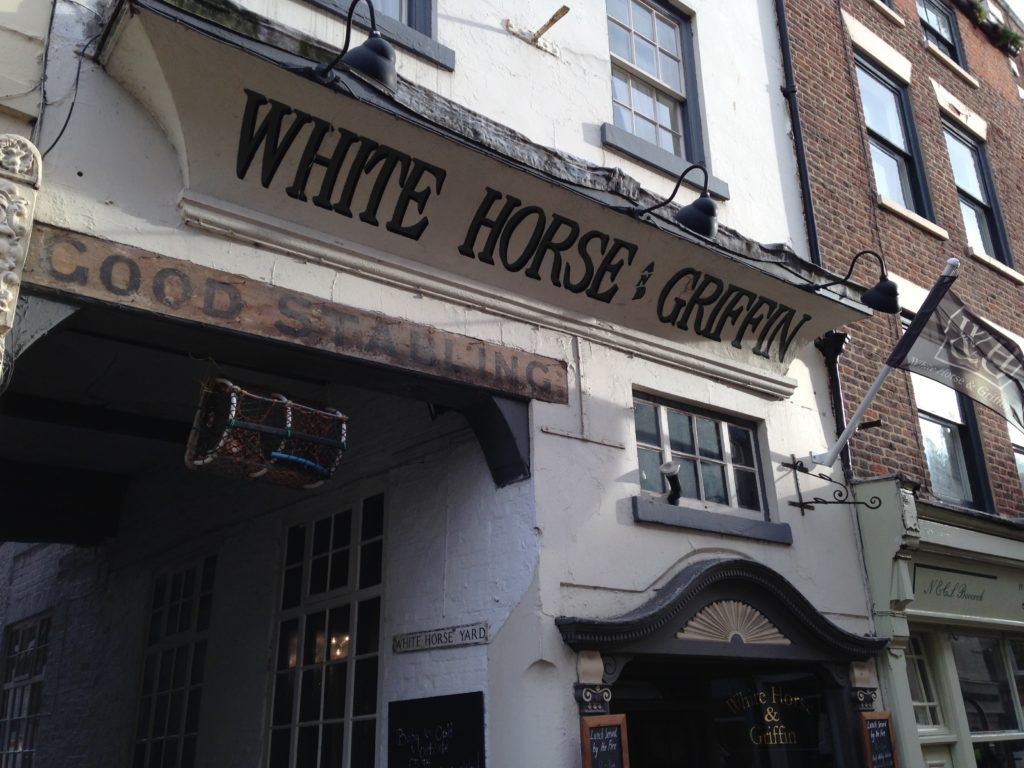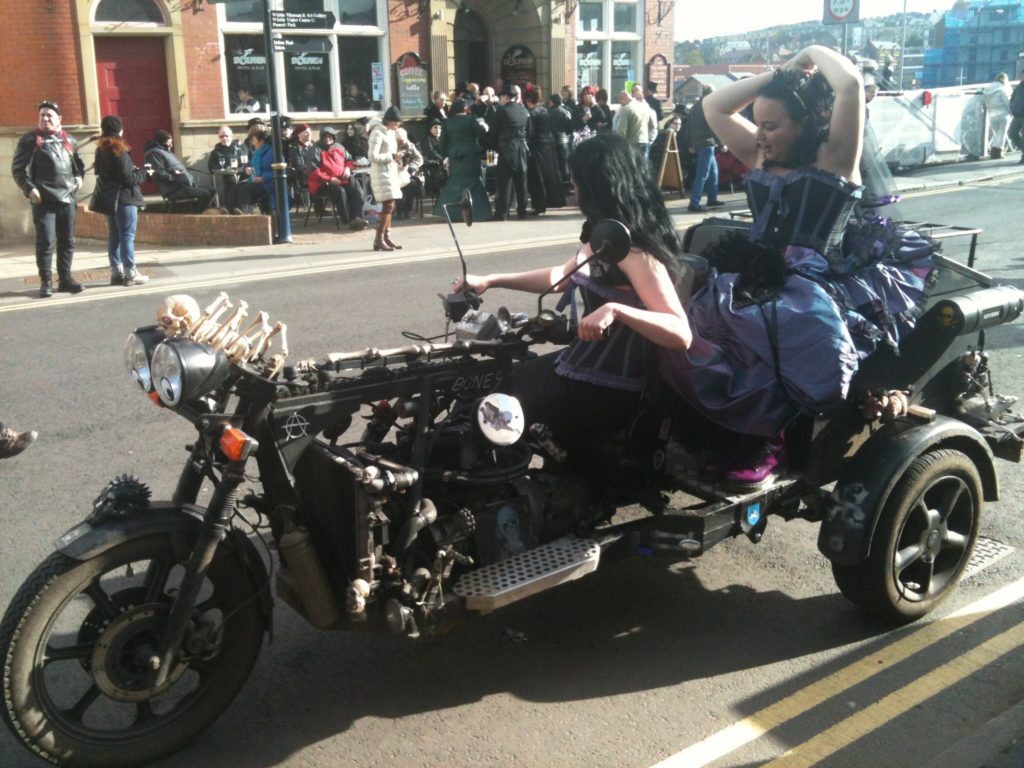In case you’re just joining us, Psychic Investigator Paul Fitz-George has been treating us to tales of Whitby’s haunts and authors connected to the city for his series, “Whitby’s Fascination for the Literati or how Dracula met the Jabberwocky.”
In Part 1 he gave us an overview of Whitby’s haunts. Part 2 was about Bram Stoker’s connection to the city. Part 3 was about Wilkie Collins. Part 4 was Lewis Carroll. Charles Dickens will be the final author Mr. Fitz-George covers. But it won’t be the last installment of his series. There is one final one to follow…

Last but not least we have the great Charles Dickens, who first visited Whitby in 1836 and who later encouraged his friend and work colleague Wilkie Collins (both of them worked on the periodical ‘All the Year Round’), to stay there.
On a later visit to Whitby in 1844, he stayed with the Marquis of Normandy at the Marquis’ stately residence of Mulgrave Castle, the large lawn of which was called ‘The Quarterdeck’ in honour of the fact that Lord Nelson had manfully strode across it. Dickens apparently and as a homage to Nelson (one assumes) danced a hornpipe on it, which must have been very interesting to watch. The Marquis was a ‘Liberal politician, travel writer, novelist and dandy’ and it was to his wife, the Marchioness Maria that Dickens dedicated one of his great novels ‘Domby and Son’ (Tomain, C, 2011).
Whilst at Whitby he also lunched at the very Dickensian looking White Horse and Griffin Inn, which is still in a more or less unchanged state to that which Dickens would have seen on his visits. It is a place full of the atmosphere of Dickens’ time and I actually considered buying it back in the eighties and opening it as either a museum or ghostly attraction, though it was in a very derelict state then and beyond my finances at that time.
It has however been thoroughly renovated now and has a good restaurant according to its reviews. Today and as in Dickens’ time, you can partake of an oyster or two, or perhaps a plate of fine Whitby dressed crab washed down with a glass of champagne, this just prior to going on one of the town’s several ghost walks.
What ghost connections then did Whitby have for our final member of this illustrious group, if any?
It’s hard to say, his biographer John Forster is on record as mentioning that as far as ghosts were concerned, Dickens has “…something of a hankering after them”.
For me ‘The Signal-man’ will always be his most memorable, though you may have your own favourite Dickens’ tale of the supernatural you believe to be his best.
He was after all a member of the London Ghost Club (established 1862 and now called simply The Ghost Club) and therefore had a keen interest either personally and more important from a literary (bringing in the pennies) sense in the supernatural.
Some direct input into his stories from the area comes from his friendship with his friend Charles Smithson, who ran a law practice in nearby Malton. Scrooge’s counting house for instance, is based on Smithson’s Chancery Lane premises in Malton.
It was at Smithson’s home at Easthope hall in the same area that he came across a woman who he used to construct the character of the drunken nurse Mrs Sarah Gamp in his novel Martin Chuzzlewit, some of which he also wrote in Malton.
As for any actual supernatural connections with Dickens and Whitby, no definite connections have been recorded…as yet.
However, this gives you an excellent excuse to come to Whitby to investigate and prove otherwise, perhaps during the upcoming Goth Weekend, 4th to 6th November. During this time of Gothic romping and promenading, you can parade along its still cobbled streets and seek out its spirit roots (both ethereal and alcoholic), ideally in one of its many old inns, whilst at the same time soaking in the wealth of historical ambiance around you, achieving (hopefully) some supernatural enlightenment.

I hope fellow delvers into the world of the supernatural that this article has helped inform you on this illustrious group of famed Victorian tale tellers and their interaction with this lovely old seaside town.
I also hope that it may want you to delve deeper into this mysterious old town’s history. To this end, I have provided a more-or-less full bibliography for you to peruse at the end of the article and I welcome any questions you may have about a place I have lived in and still to this day find fascinating, adieu!
Mr. Fitz-George’s bibliography follows below, but he has one more treat in store for us in this series. As a bonus, in Part 6 he discusses Whitby’s Wafts, Boh-Ghost, and 199 Steps. Be sure to look for it. If you dare…
Bibliography:
Books Researched
Fitz-George, Paul, (2014) ‘The Whitby Ghost Book’, Amazon, eBook Kindle Version, accessible at: – https://www.amazon.co.uk/Whitby-Ghost-Book-Paul-Fitz-George-ebook/dp/B00E675MBU
Feuer, Bryan, (2016), ‘Boundaries, Borders and Frontiers in Archaeology: A Study of Spatial Relationships’, Jefferson, North Carolina, USA, MacFarland and Company Inc.
Baker, William, (2007) ‘A Wilkie Collins Chronology’, London, UK, Palgrave Macmillan
Thompson, Ian and Frost, Roger, (2016), ‘Secret Whitby’ Merrywalks, Stroud, UK, Amberley Publishing Ltd.
McDermott, Paul, (1987) ‘The Whitby Ghost Book’, Leicester, UK, Anderson Publications. (Please note, the author has changed his name to Paul Fitz-George and this book is now available as an e-book on both Kindle and Google Books)
Stoker, Bram, (1897 reprint 1985), ‘Dracula’, Harmondsworth. UK, Penguin Books Limited
Robinson, Francis, Kildale, (1855), ‘A Glossary of Yorkshire Words and Phrases Collected in the Whitby Neighbourhood’, Soho Square, London, UK, John Russell Smith Publishers
Wakeling, Edward, (2015) ‘Lewis Carroll: The Man and his Circle’, London, UK, I. B. Tauris & Co Ltd.
Tomalin, Claire, (2011) ‘Charles Dickens: A Life’, London, UK, Hamondsworth, Middlesex, Penguin Books Ltd.
Peach, Howard, (2003) ‘Curious Tales of Old North Yorkshire’, Wilmslow, Cheshire, UK, Sigma Leisure
Web sites accessed
The Black Horse Inn Webpage 2015-2016, ‘Black Horse People’, accessed 15th July 2016 – http://www.the-black-horse.com/history/people.html#stoker
The Whitby Gazette online, ‘Descendant of Dickens to follows his Whitby footsteps’ (July 2014), accessed 15th July 2016 – http://www.whitbygazette.co.uk/what-s-on/descendant-of-dickens-to-follows-his-whitby-footsteps-1-6704372#ixzz4ETw3FcmE
Endeavour Cottages, ‘Whitby and its connections with Lewis Carroll the famous author’ (undated), accessed 15th July 2016 – http://www.endeavourcottage.co.uk/whitby-blog/lewis-carroll.html
Locker, R, ‘Out on Ye! Underground Whitby’, ‘Lewis Carroll and the Whitby Adventure’ (April 2010), accessed 15th July 2016 – http://whitbypopwatch.blogspot.co.uk/2010/04/youth-at-eve-had-drunk-his-fill-where.html
Locker, R, ‘Out on Ye! Underground Whitby’, ‘A Tale of Two Wrecks’ (October, 2011) accessed 19th July 2016 – http://whitbypopwatch.blogspot.co.uk/2011/10/tale-of-two-wrecks.html
Lewis, P, ‘Wilkie’s Aldborough’, (2000), accessed 15th July 2015 – http://www.web40571.clarahost.co.uk/wilkie/Aldeburgh/Aldeburgh.htm
Fitz-George, P, ‘English Ghosts – Archives of Doom, 20th October 2015, The Ghostly Beat of the Drummer Boy’s Drum’, (2016), accessed 19th July 2016 – http://www.englishghosts.com/page10.htm
Kozlowski, B, ‘A Dickens of a Good Ghost Story’ In Historic UK (2016), accessed 19th July 2016 – http://www.historic-uk.com/CultureUK/A-Dickens-of-Good-Ghost-Story/
Brindle, S, and Wilmott, T, ‘History of Whitby Abbey, English Heritage’, (undated), accessed 19th July 2016 – http://www.english-heritage.org.uk/visit/places/whitby-abbey/history/
Brenan, G, and de Fonblanque, E, B, Wikipedia, ‘William de Percy’ (2016), accessed 19th July 2016 – https://en.wikipedia.org/wiki/William_de_Percy
(Unnamed author), Wikipedia, ‘Doppelgänger’ (2016), accessed 20th July 2016 – https://en.wikipedia.org/wiki/Doppelgänger
Taylor, T, ‘The Haunted Museum, The Historic and Haunted Guide to the Supernatural’, (2003-2008), accessed 22nd July 2016 – http://www.prairieghosts.com/spr.html
Carroll, L, ‘Phantasmagoria’, (1869), at pinkmonkey.com, accessed 22nd July 2016 – http://pinkmonkey.com/dl/library1/carol46.pdf
Davidson, J, (2011) ‘A Hankering After Ghosts: British Library’s Charles Dickens and the Supernatural’ in ‘Culture 24’, accessed 23rd July 2016: – http://www.culture24.org.uk/history-and-heritage/literary-history/art370174
(Unnamed author), (2012) ‘The Ghost Club’, accessed 23rd July 2016: – http://www.ghostclub.org.uk/history.html
Got an idea you’d like to submit? We’re always looking for quality infotaining posts about true crime, horror, and the paranormal –or some blend thereof. Visit our Writers Wanted page for submission details. We’d love to have you join our Skeleton Crew!
P.S.
Yes.
That’s the answer to that question we know you’re wondering about. We do pay. Not a lot. Don’t get excited. But we believe in paying writers for their time and energy. You’ll find complete details on the Writers Wanted page.
